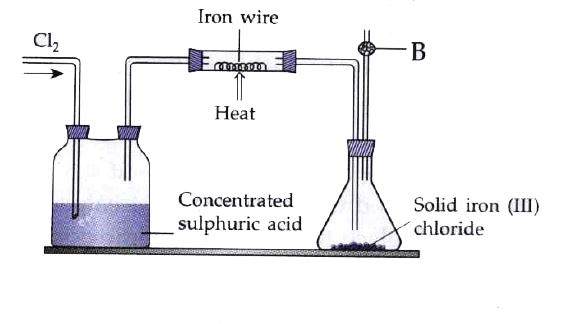Name a substance that will reduce aqueous Iron (III) ions to Iron (II) ions.
To answer the question, "Name a substance that will reduce aqueous Iron (III) ions to Iron (II) ions," we can follow these steps:
1. Identify the Ions:
- Iron (III) ions are represented as Fe³⁺ (ferric ions).
- Iron (II) ions are represented as Fe²⁺ (ferrous ions).
2. Understand the Reduction Process:
- Reduction is the gain of electrons or a decrease in oxidation state. In this case, Fe³⁺ is being reduced to Fe²⁺, which means it is gaining an electron.
3. Select a Reducing Agent:
- A reducing agent is a substance that donates electrons to another substance, thereby reducing it. We need to find a suitable reducing agent that can convert Fe³⁺ to Fe²⁺.
4. Identify Hydrogen Sulfide (H₂S):
- Hydrogen sulfide (H₂S) is known to act as a reducing agent. It can reduce Fe³⁺ ions to Fe²⁺ ions.
5. Write the Reaction:
- The chemical reaction can be represented as follows:
H2S+Fe3+→Fe2++2H++S2−
- In this reaction, H₂S donates electrons to Fe³⁺, reducing it to Fe²⁺.
6. Conclusion:
- Therefore, the substance that will reduce aqueous Iron (III) ions to Iron (II) ions is Hydrogen Sulfide (H₂S).
Final Answer:
Hydrogen Sulfide (H₂S)
- Iron (III) ions are represented as Fe³⁺ (ferric ions).
- Iron (II) ions are represented as Fe²⁺ (ferrous ions).
- Reduction is the gain of electrons or a decrease in oxidation state. In this case, Fe³⁺ is being reduced to Fe²⁺, which means it is gaining an electron.
- A reducing agent is a substance that donates electrons to another substance, thereby reducing it. We need to find a suitable reducing agent that can convert Fe³⁺ to Fe²⁺.
- Hydrogen sulfide (H₂S) is known to act as a reducing agent. It can reduce Fe³⁺ ions to Fe²⁺ ions.
- The chemical reaction can be represented as follows:
H2S+Fe3+→Fe2++2H++S2−
- In this reaction, H₂S donates electrons to Fe³⁺, reducing it to Fe²⁺.
- Therefore, the substance that will reduce aqueous Iron (III) ions to Iron (II) ions is Hydrogen Sulfide (H₂S).
Hydrogen Sulfide (H₂S)
Topper's Solved these Questions
- STUDY OF THE FIRST ELEMENT - HYDROGENBOOK - ICSECHAPTER - STUDY OF THE FIRST ELEMENT - HYDROGENEXERCISE - TOPIC 2 Properties of Hydrogen, Oxidation nd Reduction (3 MARKS QUESTIONS)
14 Videos
- STUDY OF GAS LAWS BOOK - ICSECHAPTER - STUDY OF GAS LAWS EXERCISE - TOPIC 2 (5 Marks Questions )
18 Videos
- THE LANGUAGE OF CHEMISTRYBOOK - ICSECHAPTER - THE LANGUAGE OF CHEMISTRYEXERCISE - EXCERCISE 1(C ) (Correct the following statement)
21 Videos
Similar Questions
Iron + sulphur → Iron(II) sulphide
View SolutionThe given diagram is to prepare Iron(III) chloride in the laboratory:
(i) What is substance B?
(ii) What is the purpose of B?
(iii) Why is iron(III) chloride to be stored in a closed container?
(iv) Write the equation for the reaction between iron and chlorine.

View SolutionAn iron wire is immersed in a solution containing ZnSO4andNiSO4. When the concentration of each salt is 1 M, predict giving reactions which of the following reactions is likely to proceed : (i) Iron reduces Zn+ ions (ii) Iron reduces Ni2+ ions.
Given
EΘ=−0.76V for Zn2+/Zn
EΘ=−0.44V for Fe2+/Fe
EΘ=−0.25V for Ni2+/Ni
View SolutionGive the chemical tests between the following pairs:
Iron (II) sulphate and Iron (III) sulphate.
View SolutionThe oxidation state of copper changes when aqueous copper (II) ions react with:
(I)NaOH(aq) (II)Fe(s) (III)KI(aq)
View SolutionThe oxidation state of copper changes when aqueous copper (II) ions react with:
(I)NaOH(aq) (II)Fe(s) (III)KI(aq)
View SolutionWrite the equations for the following and balance them
Iron (III) chloride dissolves in water producing Iron (III) hydroxide and hydrochloric acid.
View SolutionWhat is the formula of iron (III) sulphate?
View SolutionName the ions obtained when HCl dissociates in aqueous solution .
View SolutionThree faradays of electricity was passed through an aqueous solution of iron (II) bromide. The mass of iron metal (at mass 56) deposited at the cathode is:
View Solution